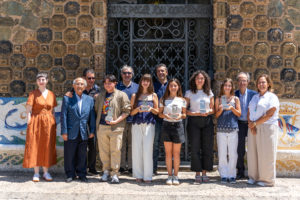August 11, 2023
By: Ferran Garcés
Very few parts -and objects- of the original palace have survived, five centuries before Gaudí, that stood in this place. The Christ in the photo is one of them. It was part of an area we will talk about today, the old chapel. A fundamental piece of the palace along with the library. Both justify the two nicknames of King Martí I, its first owner.
These nicknames were, on the one hand, “the Humanist,” in relation to humanism, the philosophy of the Renaissance characterized by intense bibliophilia, and on the other hand, “the Ecclesiastic” (1), because Martí I was also a great devotee, fond of collecting miraculous relics, attending masses, and protecting churches.
The chapel
The chapel of the Bellesguard palace was dedicated to the saints Abdó and Senén, two martyrs highly revered then in the realms of the Crown of Aragon. Thanks to the preserved letters of Martí I, we know that the king wrote to the abbot of Santes Creus asking him to send him a monk for “the Custody of said chapel” (2).
We also know that it must not have been very large, as it was of a private nature. Nevertheless, the chapel will be the part of the palace that survives the best over time. In the mid-20th century, its entrance could still be seen, although greatly renovated and converted for uses not always liturgical. The current church of the Santíssim Redemptor -a work by Bernardí Martorell, between 1919 and 1925- was built upon its scant remains.
Next, we have included two images that reflect the final state “of said chapel.” The first image is a drawing by Lluís Rigalt, dated September 1870, illustrating the appearance of Torre Bellesguard at that time. The chapel is distinguishable behind the cypress tree. The second image, post-1925, shows the exterior entrance of King Martí I’s original chapel, almost unrecognizable. In the photo, we see it integrated into the Asylum of the Oblate Sisters of the Santíssim Redemptor, a congregation that occupied the property before the current Abat Oliva University (3).
On the other hand, very few objects of the original palace have survived until today. Of them, two were part of this chapel, where Martí I celebrated his second wedding in the year 1409. The first one we’ve already seen in the header image. It’s a Christ, a gift from Margarida de Prades, the bride, and the second one corresponds to a pax, a gift from Pope Luna, the guest of honor who blessed the marriage. Currently, both are preserved at the Montserrat Museum (4).
The library
The library was possibly located on the upper floor, well illuminated by windows, as was characteristic of the residences of the nobility and the upper bourgeoisie. Thanks to the bibliographic inventory made upon Martí I’s death, we know it consisted of 312 books written in fifteen different languages and dialects. A remarkably large quantity for that era. Let’s remember that the printing press had not yet been invented, and consequently, books were copied by hand. The subjects were also quite varied: history, geography, geomancy, astrology, alchemy, philosophy…, and even a chess manual, given that the monarch was an expert player. In fact, in addition to books and relics, Martí I also collected chessboards and chess and draughts pieces.
The library of Bellesguard included both pious books and works by classical writers. Among contemporary authors, Bernat Metge, Francesc Eiximenis, and Antoni Canals stand out, all of them friends of the monarch and prominent promoters of humanism in Catalonia and Valencia. Martí I’s passion for books was so great that he made various inventories and copies, luxuriously illustrated and edited. We know, for example, that his copy of Marco Polo’s Book was protected by green leather covers. Unfortunately, shortly after the king’s death, this fabulous library was dispersed, and the trace of most of it was lost (5).
Notes
(1) Vall i Comaposada, Josep M., (2014) Bellesguard. From the residence of Martí the Humanist to the Tower of Gaudí, Duxelm editorial, Barcelona, p. 22.
Today he is better known as Martí I the Humanist, but this nickname was given by later chroniclers. Contemporary sources referred to him as “the Ecclesiastic.” More information about this nickname: Serrano Coll, M. “Portrait of King Martí the Humanist through his artistic promotion,” in Ferrer i Mallol, M. Teresa (ed.), Martí the Humanist: the last king of the Barcelona dynasty (1396-1410): the Interregnum and the Compromís de Casp (2015), Editorial IEC, Barcelona, p. 669-675.
(2) Ibid. original letter, see Annex, p. 149, letter no. 19.
(3) Ibid. p. 92-98.
More info: Bassegoda i Nonell, Joan, (2003), “The architect Bernardí Martorell i Puig (1877-1937)”, Bulletin of the Royal Catalan Academy of Fine Arts of Sant Jordi, p.45-46 (link).
(4) Ibid. p. 52-53.
(5) Ibid. p. 53-55.




